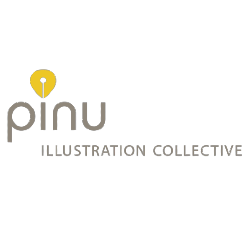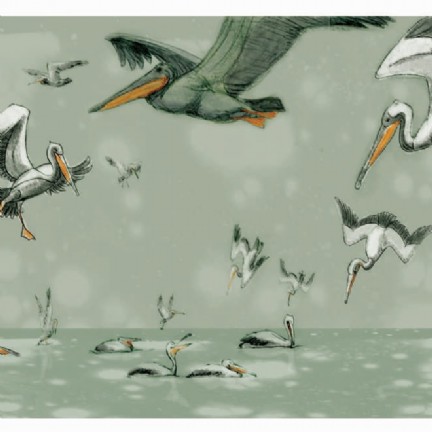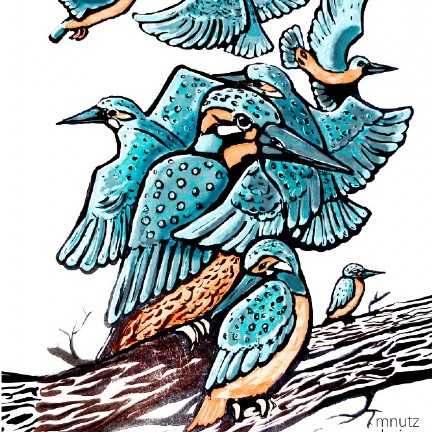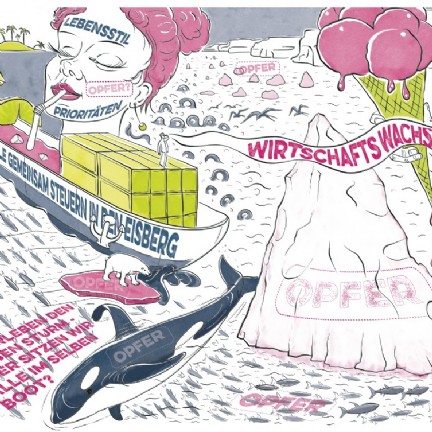In the Eye of the Pelican
Interview with Michaela Nutz, illustrator and pinu co-founder
Conducted by Christoph Schomberg
Your work is varied and yet seems to have a clear focus. I noticed the kingfishers and many other motifs from nature. How did this focus develop in your drawing work?
That's actually always been the case. From childhood, subjects such as nature, animals, but also people in dynamic movements were my favorite motifs. Through my studies, this has gained another depth. People in nature relationships, sustainability, but also environmental awareness have then occupied me more and more in drawing. And then suddenly a kingfisher sits on a branch on the Mur.
Then there are the pelicans ...
Such inspirations often come from personal experiences. With the pelicans it was like this: I was on a sailing trip and we anchored in a bay to swim. A troop of pelicans was resting there. They sit like kingfishers on branches that stick out of the water. If one dives then into the water, they come curiously closer and dive simply with. When I surfaced, one of them looked me straight in the eye. A really moving experience. In such a moment I feel I belong.
How did you start drawing and above all: why?
Drawing gave me the space to simply be for myself. That's what people still chalk up to me today, that I don't notice anything around me when I'm drawing. I then sink completely into this world. It simply relaxes me.
Has your approach changed over time?
In the very beginning, I drew out of emotional urgency. When things weren't going so well for me, as compensation. That has changed insofar as professional work requires a high degree of concentration. Then it's also a matter of being able to call up such performances and to design according to certain specifications. As strange as it sounds, you have to be able to draw even when you're feeling good. Pure emotion is no longer enough, because you often have to delve very deeply into individual topics to find the right approach to drawing. Especially if they are customer topics.
How did you discover your talent? Did you have any influences?
That has a lot to do with motor skills: Which movement sequences come easily to you? Like in sports, actually, which also occupies a large space in my life. My first influence was my father. He drew more technical things, but he was also the first to recognize and encourage my talent. And praised me. That's essential. My mother also created a very sensitive, aesthetic environment, which was also important for how I now deal with color and form.
How did your individual style come about?
Style is difficult. It's a long process to find out what suits you and to recognize what distinguishes your own work from other illustrators, especially as a professional illustrator.
The best thing I would say is: draw what comes naturally, what happens out of a certain naturalness. Of course, you also have to make compromises and be familiar with different styles in order to produce professional work accurately. That's part of it. All in all, I would say that anyone who doggedly seeks his own style is more likely to end up in the epigonal and only copy other models.
Nevertheless, the question: Did you have role models, for example certain comics?
First of all, Asterix! I was always fascinated by the dynamic, open strokes. That still influences my work as an illustrator today. Yes, and of course cartoons like Heidi, Wickie or Nils Holgerson, and later animated films like Ice Age.
Does classical painting also play a role?
For my daily work, not so much. As an influence, however, it is. I started with the Impressionists, then it became more Expressionist. I like individual artists: Paul Klee, Oskar Kokoschka and, of course, van Gogh. Of course, I'm interested in the drawings and the lesser- known watercolors. That's where you really see what they can do.
What do you value in your work with customers? How do you come up with ideas for a project?
This is a very gratifying, exciting process for me. The preliminary discussions with customers are important to me and, above all, very inspiring: empathizing with the customers' world, understanding their points of view. This communication is an essential part of the work as an illustrator. Many ideas don't come from the drawing table in the office, but rather from running in nature or with a sketchbook on the banks of the Mur - where the kingfisher can be seen from time to time.
Recently, however, we have also been seeing the pinu project, which you co-founded: a platform for illustrators that has not yet existed in Austria in this form. What is the idea, or rather the motivation behind it?
Exactly what you say: At some point we realized that there was nothing like that here yet, but there were a lot of great illustrators who were represented as lone fighters with their homepages and in social media. Our aim is twofold: First, to show a wide range of styles and perspectives, to create a site where it's fun to go on a journey of discovery. On the other hand, also intended as a service for companies.
In what way?
We know from our work in client projects that many of the clients have been searching for illustrators and the right style for a long time, but that this search on the web has often proven to be tough and random. pinu simplifies this search for companies or even projects and is intended as inspiration and orientation for professional illustrations. The spectrum is enormous: it ranges from children's book illustration, infographics and brand design to advertising illustrations and textile samples.
Are there any unifying values beyond professional illustrator work?
Definitely, and that's also important to us. pinu stands for sustainability, environmental awareness and fairness. That connects our community and is not only reflected in the illustrations.
What is your goal?
It should become easier through pinu to find exactly the right thing. Or to realize that you might have been looking for something completely different than you thought. For me, pinu is both an experiment and a matter of the heart. We want to build a lively network and a space for artistic exchange. One in which I can sink again.



